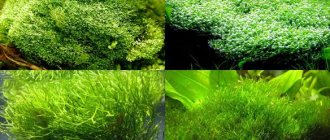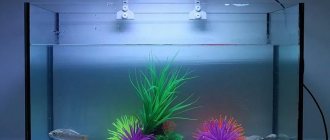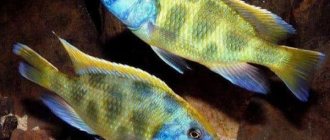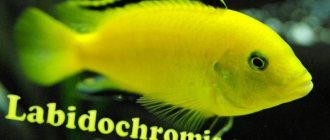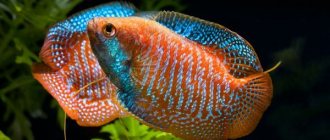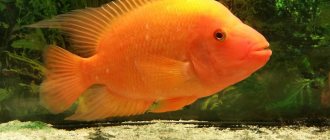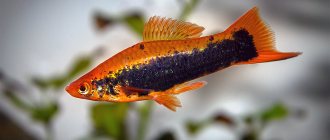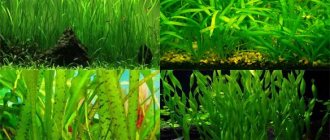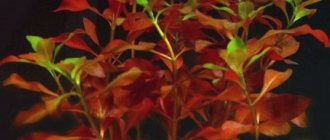Cichlids are loved by home aquarium owners for their diversity of species, bright colors and unusual habits. This is the only fish capable of recognizing its owner and carefully caring for its offspring.
In addition, family values are not alien to her, because this fish chooses a partner for life. Cichlids can breed in an aquarium and live quite a long time.
Types and description with photos
Ichthyologists classify cichlids (Cichlidae) in the order Perciformes. This one of the largest families of vertebrates includes more than two hundred genera of tropical freshwater fish living in Asia, South and Central America, and Africa.
Even experts cannot name the exact number of species, varieties, and local variations. Scientists give an approximate figure of 1186, which changes annually, thanks to the discoveries of expeditions visiting hard-to-reach places and the efforts of aquarium breeders.
Cichlid aquarium fish are divided into three large groups: Asian, American and African.
Asian cichlids
The smallest group, uniting only three species from the genus Etroplus and Iranocichla . The green etroplus, which grows to almost 50 cm in its homeland of Sri Lanka, is rarely bred in aquariums, but its relative the spotted etroplus (etropluss maculatus), rarely reaching a length of more than 8 cm, is often found in the aquariums of dwarf lovers who raise cichlids for home use.
In the genus Iranocichla, only one species, Iranocichla hormuzensis Coad, which is on the verge of extinction, has been studied and described. The fish living in the Persian Gulf countries, after an environmental disaster caused by fires in oil fields, practically disappeared and was preserved only by a few aquarists.
American cichlids
American cichlids are diverse in structure, size, color, and degree of peacefulness. Among the inhabitants of aquariums imported from South and Central America, there are several dozen genera:
Etroplus
- Angelfish (Pterophyllum scalare) are large fish (up to 15 cm in length) with a tall, laterally flattened body, a pointed head and large fins. Relatively peaceful and unpretentious. In nature they have a camouflage coloration with pronounced stripes on a main silver background. In aquarium culture, several dozen different colors are known with and without stripes (blue, black, red, diamond, gold, marble, leopard, platinum). Popular species include: common angelfish, leopold angelfish, bicolor, altum angelfish (high-finned), blue angel, koi angelfish, zebra, red devil, albino dantum, pink glowing, paraiba (phantom), dwarf.
- Acaras (Andinoacara) live in slow-moving rivers. They are characterized by a tall, flat, long body, large “browed” head, spectacular iridescent coloring, plump lips and large eyes. Sizes vary from 5 to 25 cm. Common types include: blue-spotted, blue, turquoise, spotted, electric blue, maroni, mari, Paraguayan.
- Nannacara are compact fish belonging to 6 species: nannacara anomala (green), crenicara gray (dotted), teniacara torch-tailed, red-breasted acara (letacara dorsigera), letacara curviceps. One of the most spectacular varieties is neon nannakara (electric blue, blue neon, neon akara) with a uniform iridescent blue-green color, shimmering and changing shades depending on the lighting.
- Cichlasomas are powerful, strong, hardy fish with characteristic large black “protruding” eyes and durable scales. Although cichlasomas are constantly moved from one family to another, under this familiar name aquarists know cichlasoma black-striped, severum, menonuata, diamond, meeka, sedzhika, saragdova (wine), lemon (citron), salvini, spilurum (gray), tetracantum (Cuban) , fascitum (chanchita).
- Discus fish (Symphysodon discus) are fish with an easily recognizable disc-shaped body and a pattern with 9 vertical stripes. For their capricious character, impressive size (up to 25 cm) and beauty, they are called the kings of the aquarium. There are more than a hundred varieties and hybrid forms on the aquarium fish market (discus heckel, green, leopard, brown, marlboro, cobalt, snakeskin, san mera, erapshen, red card).
- Geophagus (Geophagus) - the genus includes 25 species, including the Brazilian, red-finned and large-finned earth-eaters, geophagous Camopi, Harrera, Pallegrina, lion-headed, Peruvian, and fiery. Sizes vary from 7 to 30 cm, color and body shape are varied. Distinctive features of the genus are the cone-shaped head, high-set eyes and an unusual way of feeding (the fish take earth into their mouths and filter it, passing it through the gills, leaving everything edible in the mouth).
American cichlids also include Apistogramma, Astronatus, and Pelvikachromis (parrots).
Discus
African cichlids
African cichlids have a rather complex classification. Stand out:
- Malawian cichlids (Lake Malawi cichlids). They, in turn, are divided into two subgroups: Haplochromis and Mbuna. More than 70 species of Halochromis have been described, of which the most commonly found in aquariums are cornflower blue (Jesona), golden, long-snouted Halochromis Livingston and obliquedens. The cichlids of Lake Malawi Mbuna are very diverse, the catalog of which describes many species: labidochromis, iodotropheus, pseudotropheus, kadango, mailandia, lethrinops, melanochromis, otopharyngs, aulonacars, flowercars, buazulu and others. Malawian striped cichlids (zebras) are especially loved by aquarists - red zebra cichlid, double red zebra, melanochromis golden, johana, maingano, pseudotropheus zebra and pseudotropheus zebra blue, white mailandia, pearl likoma. Although Haplochromis and Mbuna are combined into one group, it is not recommended to house them in the same aquarium.
- Lake Victoria cichlids are expensive and rarely found among Russian aquarists. The most commonly grown Victorians are Halochromis brown and Black Neochromis.
- The cichlids of Lake Tanganyika have not been fully studied. About 200 endemic species have been described, to which new, hitherto unknown species are added every year. At home, the following are usually kept: tropheus red phoenix, moliro, ikola, cherry and nkonde; Petrohormis ikola, trevavas, texas, bulu point; Altolamprologus black and white calvus; julidochromis regan, transcriptus, ornatus, dikfeldi; Cytofilapia frontosa burundi, north zaire, neolamprologus leleupi (yellow and orange), princess of burundi.
Maintenance and care
Keeping cichlids in an aquarium follows the general rules:
- the aquarium for cichlids should be large - at least 75 liters for dwarf fish, from 200 liters for large ones (angelfish, discus);
- constant aeration and filtration of water is required;
- water is renewed weekly by 10-30%;
- the optimal water temperature is selected depending on the species ; for most cichlids the values range from 24-26 °C;
Cichlids in an aquarium
- the hardness, salinity and acidity of the water are regulated in accordance with the natural biotope of the fish - neutral fresh, almost distilled water is preferred by discus and apistogramma, a different matter is the Malawian cyclids, the maintenance of which requires alkaline water;
- the aquarium is decorated based on the natural landscape familiar to this species ; most cichlids like to swim among snags, stones, and artificial shelters;
- when creating a landscape, plants with a wide, hard leaf plate and a powerful root system are used (Anubias, Saggitaria, Echinodorus), it is better to decorate an aquarium with algae-eating fish with plastic algae;
- Small pebbles and quartz are used as soil .
Cichlids
The Cichlid family includes up to 3,000 species, which are distributed throughout the world. Almost half of them live in lakes and rivers of Africa, but colorful fish are also found in the warm rivers of South America and Asia.
They began to breed exotic pets in artificial reservoirs since the times of ancient Egypt, but in Russia and Europe they appeared only in the 20th century, they fell in love with lovers and breeders, who began to breed original and beautifully colored breeds, choosing the most peaceful species.
Cichlids in nature live in fresh or slightly salty lakes and rivers. They belong to the family of ray-tailed fish, the order of perciformes, and have sizes from 2.5 cm to a meter. The main part of Cichlids has a tall body, slightly flattened, with a large head. The commercial breed Tilapia belongs to the same family. The lifespan of fish reaches 10-15 years in an aquarium, in nature up to 20-25 years.
Table of basic parameters of maintenance, care and nutrition:
| What should be the volume of an aquarium for Cichlids? | from 150-300 liters |
| What should be the temperature in the aquarium for Cichlids? | from +20-28 °C |
| What pH should be in the aquarium? | from 6-8 pH |
| What should be the hardness of the water in the aquarium? | from 5-15° dH |
| What should be the substrate for an aquarium? | any |
| What kind of lighting should be in the aquarium? | moderate |
| What should be the movement of water in the aquarium? | moderate |
| Maximum fish size | from 2.5 cm to a meter (depending on the type) |
| What does aquarium fish eat? | depends on the type: aquarium plants; dry food; live food: daphnia, tubifex, bloodworms |
| Type of aquarium fish | aggressive |
| Who is compatible with in an aquarium? | get along with all non-aggressive fish species that do not fit in the mouth |
| Lifespan | up to 10-15 years |
Compatibility with other fish
Cichlids have a reputation for being brawlers and bullies; when kept together, their tankmates are often attacked or even eaten. Aggression increases during spawning; it is better to place the future parents in a separate dwelling.
By raising fry of different species of cichlids together in one large aquarium equipped with the required number of shelters, pugnacity in adulthood can be avoided, but the rule does not apply to discus fish, angelfish, and apistogramma.
Aggressive species (American, Malawian) should not be added to:
- guppy;
- cockerels;
- swordtails;
- zebrafish;
- mollies;
- goldfish.
Asian cichlids and some smaller varieties are quite peaceful and get along well with other fish.
Danio
What to feed in the aquarium?
Depending on the food supply of fish, cichlids are divided into:
- vegetarians (herbivores);
- carnivores (animal eaters);
- omnivores (fish that readily eat both plant and animal food).
The best food for cichlids will be food that is familiar to a particular species in the natural environment, but in our conditions it is difficult to provide them with flora and fauna from African lakes or American rivers. Therefore, you can feed the fish:
- natural food (live or frozen crustaceans Artemia, Cyclops, Diaptomus, Daphnia, bloodworms, coretra);
- dry food (Tetra, JBL, Tropical, Sera, Wardley, Aquamenu);
- dry algae (spirulina);
- feed mixtures , sea fish (hake, cod, pink salmon);
- minced meat or pieces of seafood (squid, shrimp, mussels);
- scalded green mass of plants (lettuce, dandelions, nettles, cabbage);
- canned vegetables (green peas, corn);
- fresh vegetables (cucumber, carrots, zucchini, pumpkin, spinach, bell pepper).
Carrot
Feeding rules
Bright beauties are classified as predators with a mixed menu. Tropical guests eat almost all types of frozen and live food presented in pet stores. Fresh seafood and squid are allowed as food. The meat of warm-blooded animals is poorly digestible, so adding it to the diet is undesirable. Vegetables allowed in limited quantities:
- zucchini;
- cucumbers;
- green pea;
- salad.
Prone to mild obesity
Cichlids are prone to gluttony, which forces the owner to control the amount of food eaten and the frequency of feeding. It is recommended for adult specimens to have fasting days once a month. Cunning pets adapt to the owner’s character and learn to beg for food. Obesity is a common cause of death in livestock, so there is no need to succumb to provocations.
Reproduction
For successful reproduction, cichlids need comfortable conditions - properly selected neighbors, a special complete balanced feeding ration, readiness of the male and female for mating, a separate, well-equipped spawning area with a volume of at least 80 liters.
Cichlid fish are very caring parents, jealously protecting their eggs, laid in sand pits, on plant leaves, and flat stones. Some species even carefully carry caviar in their mouths.
But despite the increased attention, the fry should not be kept with their parents for too long; without waiting until the adults begin to show aggression, the babies are transplanted to a permanent place of residence.
Characteristic
The Cichlidae family is considered quite large; it includes dozens of species of fish living in Africa or America. To date, approximately 1,300 genera of cichlid fish have been described; together with little-studied varieties, they number about 2,000, for this reason they can be called the largest family. The color is striking in its colorfulness and attractiveness. They differ from many other inhabitants of aquariums in the specifics of reproduction and care of offspring.
Breeding these fauna representatives is not always easy. Cichlids are fish whose reproduction occurs in this way: females clean stones, grottoes or wide leaves of plants and attach eggs to them. They can also breed or spawn in a small dug hole that is prepared in advance. Some individuals are able to transfer eggs into the mouth, and the female, who wants to eat, passes it on to the male. In case of danger, the eggs are hidden in the oral cavity.
Diseases: external signs and treatment
American and Asian cichlids get sick quite rarely. African fish sometimes suffer from bloating. Symptoms of the disease:
- appetite suppression;
- the desire to take refuge in a shelter, lie on the bottom, hover on the surface of the water;
- lethargy;
- whitish thread-like stool;
- redness in the anal area;
- swollen abdomen (indicates a fatal stage of the disease; the fish cannot be saved).
Golden cichlid
Treatment is carried out according to the following scheme:
- Place the sick fish in a separate container , increase aeration, turn off filters and sterilization.
- Dissolve bitter Epsom salt metronidazole (sold in pharmacies as a laxative) in water in a ratio of 2-3 tablespoons per 45 liters of water.
- Twice a day, the water in the “infirmary” is replaced by half the volume and the drug is added again.
- The course of treatment is 4-5 days , if the fish has not recovered, but has not died, take a break for 2-3 days and repeat the procedure.

